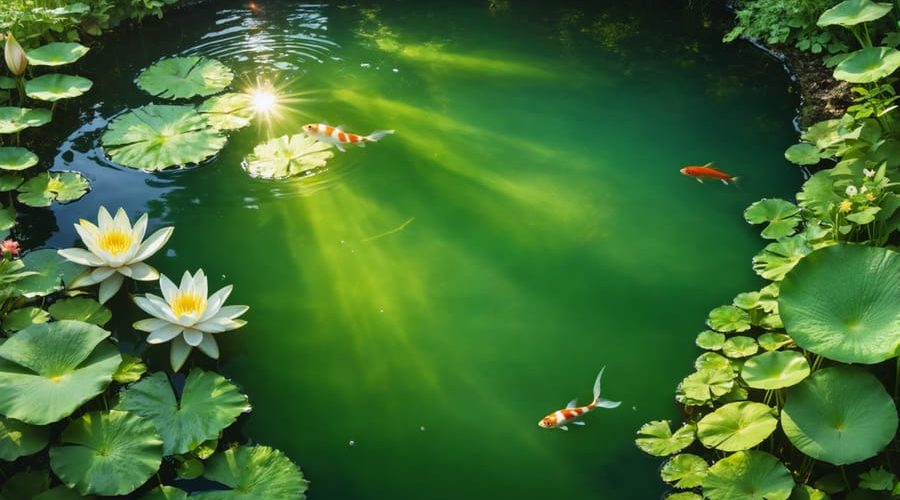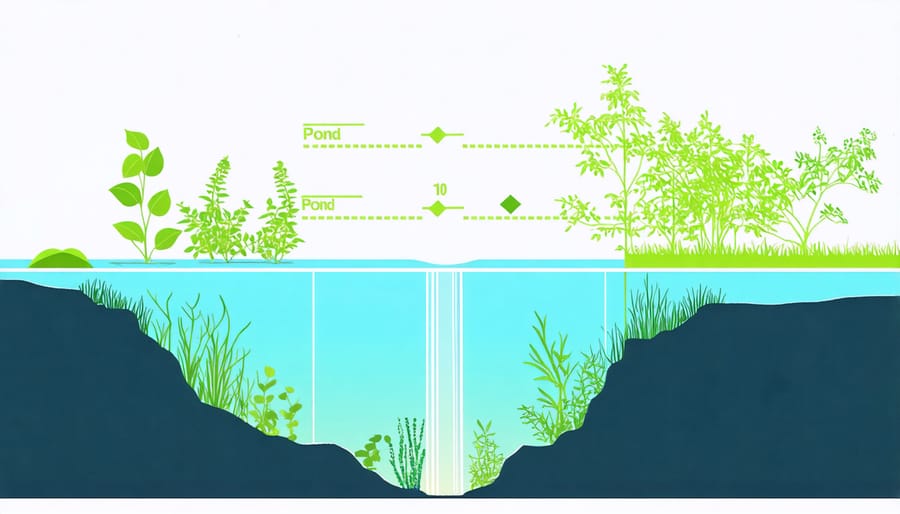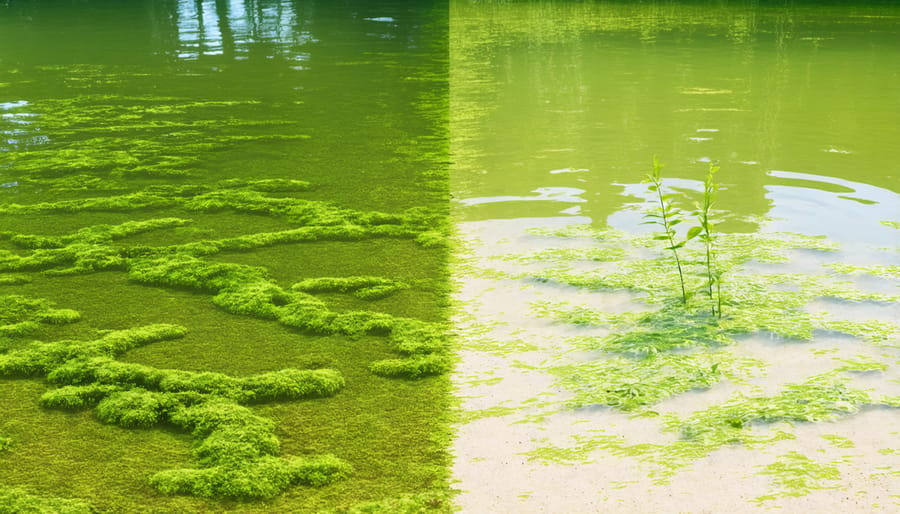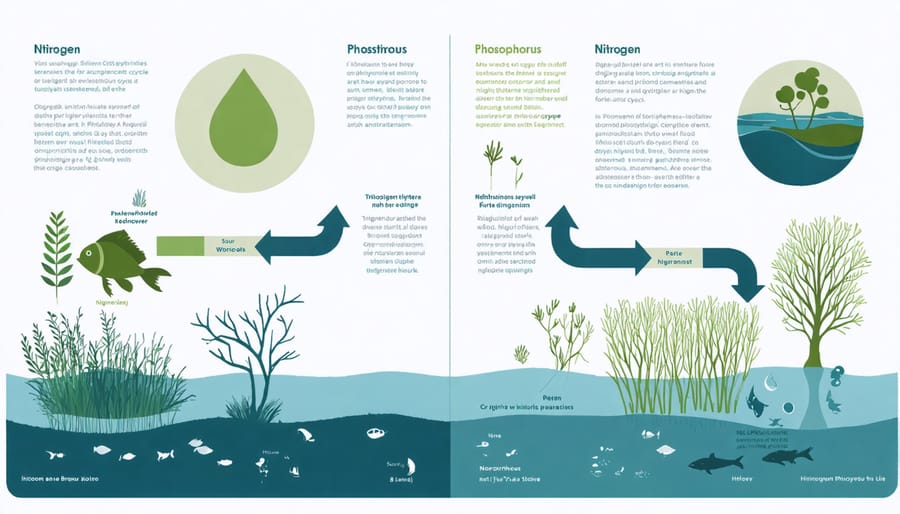
Light and Nutrients: The Secret Recipe for Thriving Pond Life
Primary productivity in aquatic ecosystems holds the key to a thriving pond environment, much like sunlight powers a solar-powered garden. Light penetration through water drives this underwater energy factory, where microscopic algae and aquatic plants transform sunlight into the vital building blocks that fuel all pond life. Whether you’re maintaining a backyard water garden or managing a larger pond, understanding these fundamental processes helps you create the perfect conditions for a flourishing underwater world. The interplay of sunlight, nutrients, and temperature determines how efficiently your pond’s plant life produces energy – making these factors crucial for any pond owner to monitor and optimize. By mastering these elements, you’ll unlock the secret to crystal-clear water and healthy aquatic life, transforming your water feature into a vibrant, self-sustaining ecosystem that brings joy year-round.
Sunlight: The Foundation of Aquatic Life
The Role of Water Depth
Water depth plays a crucial role in how productive your pond or water garden can be. Think of water as a series of layers, each affecting how much light reaches different depths. As sunlight travels through water, it gradually becomes dimmer – just like how it’s harder to see the bottom of a deep pool compared to a shallow one.
The uppermost layer, called the photic zone, is where most of the action happens. This is where sunlight easily penetrates, allowing underwater plants and algae to photosynthesize and thrive. In most backyard ponds, this zone extends several feet deep, making it perfect for growing beautiful water lilies and other aquatic plants.
Below this, you’ll find the aphotic zone, where light becomes too weak for photosynthesis. While this deeper area might not contribute much to primary productivity, it’s still important for your pond’s ecosystem, providing shelter for fish and helping maintain water temperature.
For home pond owners, understanding these zones helps in planning plant placement and maintaining a healthy balance in your water garden. Shallow shelves around the pond’s edges are perfect for marginal plants, while deeper areas work well for submerged plants and fish habitats.

Water Clarity Matters
Think of your pond as a sunlit greenhouse – the clearer the glass, the better the plants grow inside. Water clarity plays a crucial role in how much sunlight reaches the underwater plants that power your pond’s ecosystem. When water becomes cloudy or murky (what experts call turbid), it’s like putting a shade cloth over your garden – less light gets through, and plant growth slows down.
Suspended particles, whether from algae, sediment, or debris, act like tiny mirrors in the water, bouncing light back to the surface instead of letting it reach deeper areas. This significantly reduces the depth at which photosynthesis can occur, limiting the productive zone of your pond. Clear water, on the other hand, allows sunlight to penetrate deeper, creating a larger area where aquatic plants can thrive and produce oxygen.
To maintain good water clarity, regular maintenance is key. Remove fallen leaves promptly, manage fish populations appropriately, and consider adding aquatic plants that help stabilize the bottom sediment. Your reward will be a more productive and healthier pond ecosystem.

Essential Nutrients for Pond Productivity
Nitrogen and Phosphorus Balance
Think of nitrogen and phosphorus as the dynamic duo of pond nutrition – they’re absolutely essential for your aquatic plants to thrive! Nitrogen helps plants build proteins and grow lush, green foliage, while phosphorus is crucial for root development, flowering, and overall plant health.
In a well-balanced pond, these nutrients naturally cycle through the ecosystem. Fish waste, decomposing plant matter, and beneficial bacteria all play their part in maintaining healthy nutrient levels. However, too much of a good thing can spell trouble! Excess nutrients, especially phosphorus, can trigger algae blooms that turn your crystal-clear pond into a green soup.
The key is finding the sweet spot. Regular water testing helps you monitor nutrient levels, while adding floating plants like water lilies can help absorb excess nutrients. If levels get too high, consider reducing fish feeding or installing a biological filter. Too low? Natural fertilizers designed specifically for aquatic plants can give your pond the boost it needs.
Remember, a balanced ecosystem is a healthy ecosystem. By keeping an eye on these vital nutrients, you’ll create the perfect environment for your aquatic garden to flourish.

Maintaining Healthy Nutrient Levels
Maintaining a healthy pond ecosystem requires careful attention to nutrient levels. Start by testing your water monthly using a reliable test kit to monitor nitrogen, phosphorus, and other essential nutrients. Add beneficial bacteria regularly to help break down excess nutrients and prevent algae blooms.
Consider incorporating floating plants like water lilies or water hyacinths, which naturally absorb excess nutrients while providing shade. Install a proper filtration system and clean it regularly to remove debris that could decompose and release nutrients back into the water.
Feed fish sparingly, as uneaten food contributes to nutrient buildup. A good rule of thumb is to only feed what your fish can consume within 5 minutes. Perform partial water changes (about 10-15%) every few weeks to dilute accumulated nutrients.
If you notice signs of nutrient imbalance, such as murky water or excessive algae growth, try adding barley straw or activated carbon to help absorb excess nutrients. Remember, prevention is easier than correction, so maintain regular testing and maintenance schedules.
Temperature and Seasonal Changes
Temperature plays a fascinating role in your pond’s productivity throughout the year, much like a thermostat controlling your home’s comfort level. During warmer months, when sunlight bathes your pond in warmth, the water temperature rises, creating ideal conditions for algae and aquatic plants to thrive. These little green powerhouses work overtime, converting sunlight into energy and producing more oxygen for your fish.
However, as seasons change, so does your pond’s productivity. In spring and early summer, you’ll notice an explosion of growth as temperatures reach that sweet spot between 68-86°F (20-30°C). This is when your water garden really comes alive! Plants spread their leaves, and algae multiplication reaches its peak, creating a bustling underwater community.
Winter tells a different story. As temperatures drop below 50°F (10°C), primary productivity slows dramatically. Your pond plants and algae enter a sort of hibernation mode, producing less energy and oxygen. Think of it as your pond taking a well-deserved winter break. During these colder months, you’ll notice clearer water and slower plant growth.
Fall and spring serve as transition periods, where productivity gradually shifts up or down. These seasonal changes are completely normal and healthy for your pond ecosystem. Understanding these temperature-driven cycles helps you better care for your water garden. You’ll know when to expect growth spurts, when to adjust feeding schedules for fish, and when to plan your maintenance activities.
Remember, each pond responds slightly differently to temperature changes based on its depth, location, and plant variety. Getting to know your pond’s unique seasonal rhythm is key to maintaining a thriving aquatic ecosystem year-round.
Practical Tips for Pond Owners
Want to boost your pond’s primary productivity? Here are some hands-on tips for maintaining optimal pond conditions that will help your aquatic ecosystem thrive:
Start by ensuring proper sunlight exposure – trim back overhanging branches that cast too much shade on your pond. Aim for 4-6 hours of direct sunlight daily to support photosynthesis. If your pond gets too much sun, consider adding floating plants like water lilies to provide balanced shade.
Monitor your water quality regularly. Keep pH levels between 6.5 and 8.5, and test for ammonia and nitrates monthly. A simple water testing kit from your local garden center will do the trick. Add beneficial bacteria products in spring to jump-start the biological cycle.
Control nutrient levels by removing fallen leaves promptly and avoiding over-feeding fish. A good rule of thumb is to feed only what your fish can consume in 5 minutes. Install a proper filtration system sized for your pond volume, and clean it according to manufacturer guidelines.
Add underwater plants like hornwort or anacharis – they’re excellent oxygenators and natural filters. Create different depth zones in your pond to support various plant types. Deep zones (2-3 feet) work great for water lilies, while shallow shelves are perfect for marginal plants.
Remember to maintain a healthy balance between plants and fish. Too many fish can upset your pond’s ecosystem by producing excess waste. As a general guideline, allow 1 inch of fish per 10 gallons of water. Regular partial water changes (about 10-15% monthly) help maintain this delicate balance.
Primary productivity in your aquatic ecosystem depends on a delicate balance of several key factors. By maintaining proper light levels, ensuring adequate nutrient availability, and monitoring water quality, you can create a thriving environment for your pond’s plant life. Remember, a healthy ecosystem starts with these basics, but it’s the ongoing care and attention that makes the difference. Take small steps to improve your pond’s conditions, like regular water testing and careful plant selection. Whether you’re just starting out or looking to enhance your existing water garden, focusing on these fundamental elements will help you create a more vibrant and sustainable aquatic environment. Why not start today by checking your pond’s sunlight exposure or testing your water quality? Your underwater garden will thank you with lush growth and crystal-clear waters.
